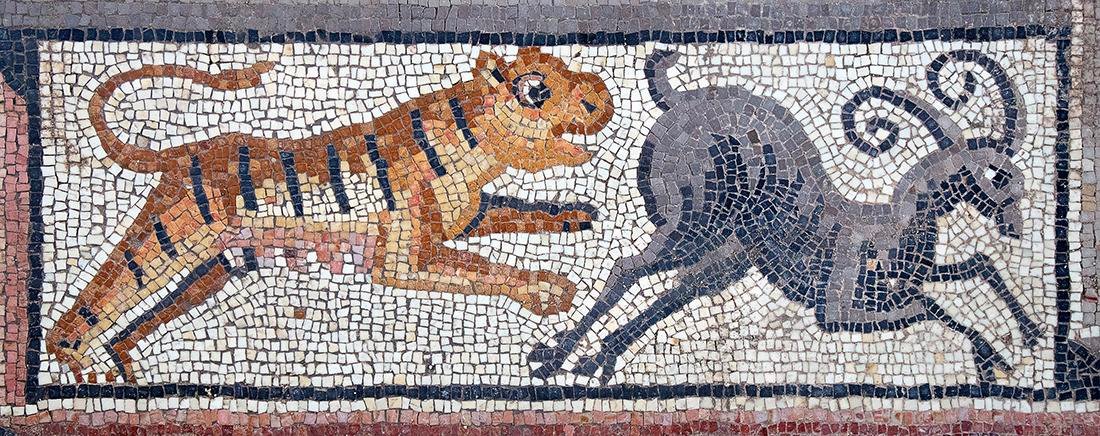A team of archaeologists, led by University of North Carolina at Chapel Hill Professor Jodi Magness, have made an astounding discovery during the 11th and final season of excavations at the late Roman synagogue in Huqoq, Israel’s Lower Galilee.
The team uncovered a spectacular mosaic panel just inside the main entrance of the synagogue. This panel, which serves as a commemoration, bears an enigmatic Hebrew inscription within a wreath, flanked by lions resting their forepaws on bulls’ heads.
 Tiger chasing ibex. Decorative border panel found by Dr. Magness in Huqoq. Credit: Jim Haberman, UNC
Tiger chasing ibex. Decorative border panel found by Dr. Magness in Huqoq. Credit: Jim Haberman, UNC
The surrounding Aramaic inscription lists the names of donors or artists involved in funding or creating the mosaics for the synagogue, expressing a desire for their remembrance.
This recent excavation also exposed additional sections of mosaic panels, previously discovered in 2012 and 2013, depicting scenes from the life of the biblical hero Samson, including his encounter with foxes.
Among the extraordinary finds left by the sweeping archaeological project at Huqoq are depictions of various biblical stories and figures. Notably, the earliest known portrayals of the biblical heroines Deborah and Jael were discovered in a panel in the southwest aisle. This panel shows Deborah under a palm tree, gazing at Barak with his shield, and Jael hammering a tent stake through the temple of Canaanite general Sisera.
Other remarkable discoveries include a Hebrew inscription surrounded by human figures, animals, and mythological creatures, including putti (cupids).
The site also features the first non-biblical story ever found decorating an ancient synagogue, potentially depicting the legendary meeting between Alexander the Great and the Jewish high priest.
Additionally, there are panels depicting two spies carrying a cluster of grapes, scenes from Isaiah, the four beasts from the Book of Daniel, the oasis of Elim from Exodus, Noah’s Ark, the parting of the Red Sea, a Helios-zodiac cycle, Jonah being swallowed by three fish, and the Tower of Babel.
Archaeologists also revealed evidence of reconstruction and expansion in the early 14th century CE., during the late medieval/Mamluk period, coinciding with the establishment of a new international highway connecting Cairo and Damascus near Huqoq.
This development, alongside the rise of a tradition identifying the nearby Tomb of Habakkuk as a focal point of late medieval Jewish pilgrimage, likely contributed to the synagogue’s increased strategic importance.
The recent excavations unveiled an enormous stone-paved courtyard with a row of columns known as a colonnade to the east of the synagogue. This area was later reused in the late medieval period when a large, vaulted structure of unknown purpose was built atop it.
With the conclusion of the final excavation season, the site will be handed over to the Israel Antiquities Authority and the Keren Kayemet Le’Israel (Jewish National Fund), who plan to develop it into a unique tourist attraction, preserving and showcasing the rich historical significance of Huqoq’s ancient synagogue and its breathtaking mosaic art.





